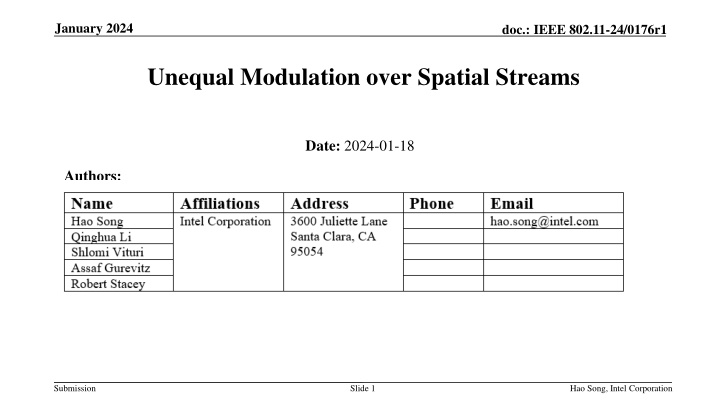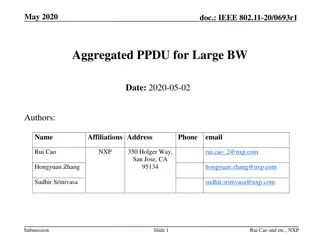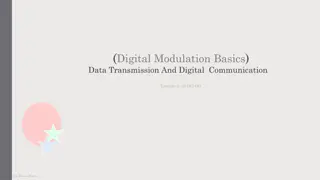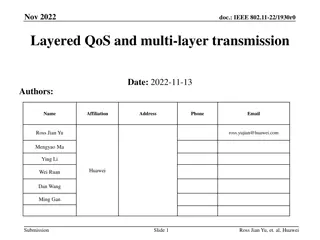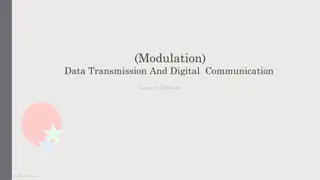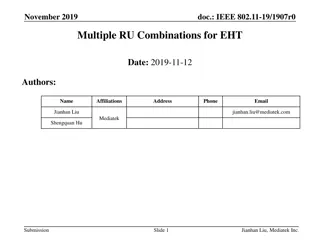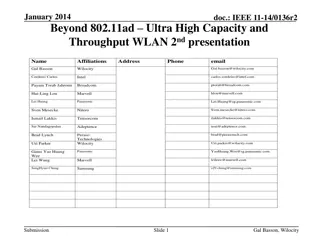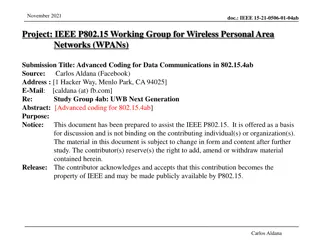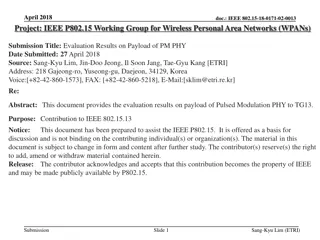Maximizing Throughput in IEEE 802.11 Networks Through Unequal Modulation Strategies
The documents discuss the benefits of using unequal modulation over spatial streams in IEEE 802.11 networks to enhance throughput. Unequal modulation allows for adapting modulation schemes based on Signal-to-Noise Ratio (SNR) conditions, optimizing MIMO gains and coding rates for each spatial stream. By assigning varying modulations and coding rates to different streams, higher efficiency and data transmission rates can be achieved. The comparison of unequal modulation with unequal MCS (Modulation and Coding Scheme) reveals the advantages and complexities associated with each approach, with unequal modulation being the recommended choice due to its compatibility with current specifications and optimization potential.
Download Presentation

Please find below an Image/Link to download the presentation.
The content on the website is provided AS IS for your information and personal use only. It may not be sold, licensed, or shared on other websites without obtaining consent from the author.If you encounter any issues during the download, it is possible that the publisher has removed the file from their server.
You are allowed to download the files provided on this website for personal or commercial use, subject to the condition that they are used lawfully. All files are the property of their respective owners.
The content on the website is provided AS IS for your information and personal use only. It may not be sold, licensed, or shared on other websites without obtaining consent from the author.
E N D
Presentation Transcript
January 2024 doc.: IEEE 802.11-24/0176r1 Unequal Modulation over Spatial Streams Date: 2024-01-18 Authors: Submission Slide 1 Hao Song, Intel Corporation
SNR Imbalance over Spatial Streams doc.: IEEE 802.11-24/0176r1 SNR imbalance may occur over spatial streams. In singular value decomposition (SVD)-based beamforming, the MIMO gain concentrates on the first few spatial streams with a larger singular value. ?1 ? ? = ? ?? ?1> ?2> > ?? Non-zero singular values are in a decreasing order > > ?? Assign varying modulations/MCSs to different spatial streams to adapt to their SNR conditions for higher throughput. Submission Slide 2 Hao Song, Intel Corporation
Equal Modulation doc.: IEEE 802.11-24/0176r1 LDPC codeword 64 QAM with 3/4 coding rate Spatial stream 1 64 QAM with 3/4 coding rate Spatial stream 2 Data transmitted on spatial streams share the same MCS and encode together. The same number of bits in a LDPC codeword are transmitted on different spatial streams. Submission Slide 3 Hao Song, Intel Corporation
Unequal Modulation doc.: IEEE 802.11-24/0176r1 LDPC codeword 16 QAM with 3/ 4 coding rate 256 QAM with 3/4 coding rate Spatial stream 1 Spatial stream 2 Data transmitted on spatial streams share the same code rate and encode together. Only modulations are different. The majority of bits in a LDPC codeword are transmitted on strong spatial streams with high MIMO gains and high-order modulations. Unequal modulation is compatible with the current EHT specifications in joint encoding between spatial streams. Submission Slide 4 Hao Song, Intel Corporation
Unequal MCS doc.: IEEE 802.11-24/0176r1 LDPC codeword Spatial stream 1 256 QAM with 3/4 coding rate LDPC codeword Spatial stream 2 16 QAM with 2/3 coding rate LDPC encoding and decoding operate individually on different spatial streams. Spatial streams have varying modulation and coding schemes (MCSs). Strong spatial streams transmit more LDPC codewords compared to weak spatial streams. Submission Slide 5 Hao Song, Intel Corporation
Unequal Modulation vs Unequal MCS doc.: IEEE 802.11-24/0176r1 Unequal modulation: o Strong spatial streams can help weak spatial steams in LDPC decoding, as they encode together. o The current transmitter and receiver in the EHT specifications are still applicable. o Minor changes are needed for stream parsers and segment parsers. Unequal MCS: o It has more freedom on coding rates of spatial streams compared to Unequal modulation. o Major changes are required to the current transmitter and receiver. o Each spatial stream has independent scrambling, encoding, and padding. o High complexity and high cost in hardware. Unequal modulation is preferred and recommended. Submission Slide 6 Hao Song, Intel Corporation
Simulation setup doc.: IEEE 802.11-24/0176r1 SVD precoding at transmitter MMSE at receiver 4 2 MIMO Bandwidth: 80 MHz IEEE model D NLOS LDPC codeword length: 1944; 10 channel realizations considered Exhaustive search used to obtain optimal MCS given a channel realization Investigated schemes: o Equal MCS with standard MCSs (existing14 MCSs listed in the current EHT- MCSs); o Unequal modulation with standard MCSs (existing14 MCSs listed in the current EHT-MCSs); o Unequal modulation with all possible MCSs (all 28 possible MCSs; used as optimum scheme) Submission Slide 7 Hao Song, Intel Corporation
Simulation results doc.: IEEE 802.11-24/0176r1 With standard MCSs, 2.5 dB gain can be achieved by Unequal modulation compared to Equal MCS. The performance of Unequal modulation with standard MCSs is close to that of Unequal modulation with all possible MCSs, demonstrating that Unequal modulation can work well with the existing standard MCSs. Submission Slide 8 Hao Song, Intel Corporation
Summary doc.: IEEE 802.11-24/0176r1 Unequal modulation is recommended with the following reasons: o Around 2.5 dB gain can be obtained by Unequal modulation in the MIMO 4 2 scenario; o Unequal modulation is compatible to the current EHT specifications, and only minor changes are required with low complexity and low cost; o Unequal modulation can work well and has excellent performance with the existing EHT-MCSs. Submission Slide 9 Hao Song, Intel Corporation
doc.: IEEE 802.11-24/0176r1 Thank you ! Submission Slide 10 Hao Song, Intel Corporation
